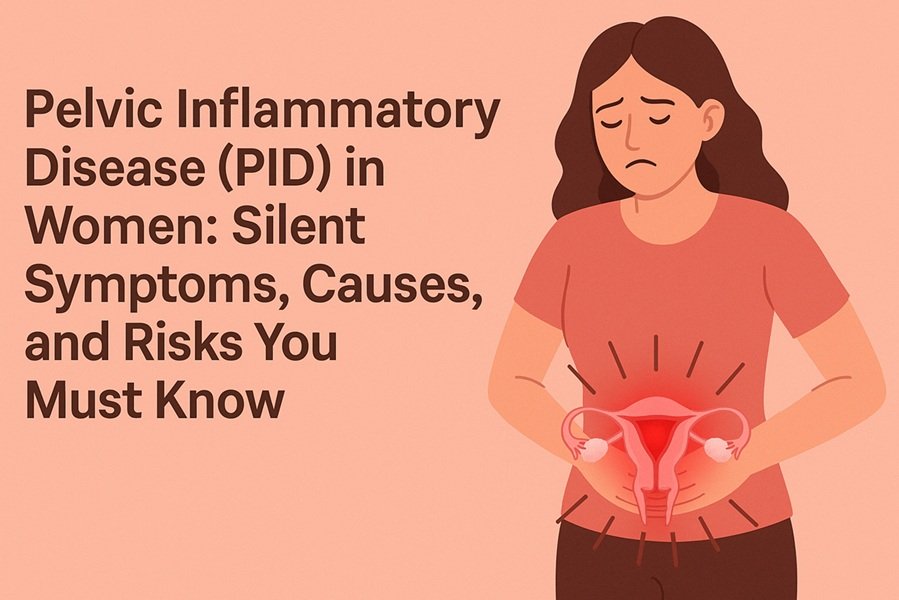
Pelvic Inflammatory Disease (PID) is a serious infection of the female reproductive organs, including the uterus, fallopian tubes, and ovaries. Often called a “silent” disease because many women experience few or no symptoms, PID can cause lasting damage if left untreated. In fact, untreated PID is one of the leading causes of infertility in women worldwide.
Understanding the hidden signs, causes, and long-term risks of PID is essential for women’s reproductive health and overall well-being.
What is Pelvic Inflammatory Disease (PID)?
Pelvic Inflammatory Disease occurs when harmful bacteria enter the reproductive tract, usually through the cervix, and spread upward to the uterus and fallopian tubes. The most common culprits are sexually transmitted infections (STIs) like chlamydia and gonorrhea, but other types of bacteria can also trigger PID.
If detected early, PID can be treated with antibiotics. However, delayed diagnosis may lead to chronic pelvic pain, infertility, or even life-threatening complications.
Silent Symptoms of PID
PID is tricky because many women do not recognize its symptoms right away. Some may dismiss them as menstrual cramps, digestive issues, or stress-related discomfort. This silent progression makes it particularly dangerous.
Common but Subtle Symptoms:
- Lower abdominal or pelvic pain – often dull, persistent, and sometimes mistaken for period pain.
- Abnormal vaginal discharge – unusual color, consistency, or foul odor.
- Irregular menstrual bleeding – spotting between cycles or heavier periods.
- Pain during sex (dyspareunia) – discomfort or sharp pain during intercourse.
- Burning sensation while urinating – often confused with urinary tract infections (UTIs).
- Low-grade fever and fatigue – mild symptoms that are easy to overlook.
Severe Symptoms (usually in advanced PID):
- High fever with chills
- Severe pelvic or abdominal pain
- Nausea and vomiting
- Fainting or dizziness (signs of serious infection or abscess rupture)
Causes and Risk Factors of PID
The majority of PID cases stem from untreated sexually transmitted infections (STIs), but several other factors can increase the risk.
Main Causes:
- Chlamydia trachomatis – the most common cause of PID.
- Neisseria gonorrhoeae – another leading STI linked to PID.
- Other bacterial infections – bacteria from the vagina (e.g., bacterial vaginosis) that spread upward.
Risk Factors:
- Unprotected sex with multiple partners
- History of STIs or previous PID episodes
- Use of intrauterine device (IUD) without proper medical screening
- Douching – disrupts the vaginal balance and pushes bacteria upward
- Young age (15–25 years) – younger women are more susceptible due to cervical physiology
Risks and Complications of Untreated PID
If left untreated, PID can lead to severe and long-lasting consequences.
- Infertility – damage and scarring of the fallopian tubes can block fertilization.
- Ectopic pregnancy – scarring may cause a fertilized egg to implant in the fallopian tube instead of the uterus, which can be life-threatening.
- Chronic pelvic pain – persistent pain even after infection clears due to scar tissue.
- Abscess formation – pus-filled pockets may develop in the reproductive tract.
- Sepsis – severe, widespread infection in advanced cases.
Diagnosis of PID
Doctors rely on a combination of medical history, physical exams, and lab tests to diagnose PID.
- Pelvic exam – checks for tenderness and abnormal discharge.
- Cervical swabs – test for chlamydia, gonorrhea, and other bacteria.
- Ultrasound or MRI – used to detect abscesses or inflammation.
- Blood and urine tests – check for infection markers.
Because symptoms can be subtle, many cases are diagnosed late, highlighting the importance of routine check-ups and STI screening.
Treatment of PID
Medical Management:
- Antibiotics – usually a combination to cover multiple bacteria.
- Hospitalization – for severe cases involving abscesses or high fever.
- Surgery – in rare cases, abscess drainage or removal of damaged tissue may be necessary.
Lifestyle and Prevention:
- Early STI treatment – prompt management of chlamydia and gonorrhea lowers PID risk.
- Safe sex practices – consistent use of condoms and limiting partners.
- Regular gynecological check-ups – early detection through screening.
- Avoid douching – helps maintain the natural vaginal balance.
When to Seek Medical Help
Seek medical care immediately if you experience:
- Sudden, severe pelvic pain
- High fever with vaginal discharge
- Fainting or signs of shock
- Persistent discomfort that doesn’t improve with rest or over-the-counter remedies
Early intervention can prevent long-term damage and protect fertility.
Conclusion
Pelvic Inflammatory Disease (PID) is often a silent threat to women’s reproductive health. While symptoms may be subtle, the risks are far from minor—ranging from infertility to life-threatening complications. Awareness, preventive measures, and early treatment are the best defenses against PID.
Regular check-ups, safe sex practices, and open communication with healthcare providers can help women detect infections early and safeguard their reproductive health.







